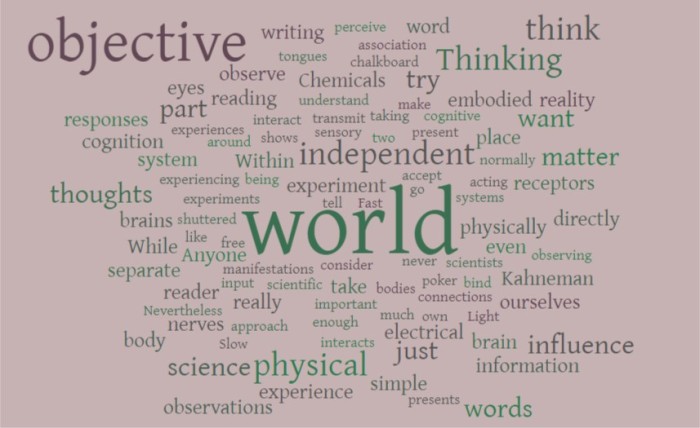I really enjoy science podcasts, science writing, and trying to think rationally and scientifically when I observe and consider the world. Within science, when we approach the world to better understand the connections that take place, we try to isolate the variables acting on our observations or experiments. We try to separate ourselves from the world so that we can make an objective and independent observation of reality, free from our own interference and influence. Nevertheless, it is important to remember that we are part of the world, and that we do have an influence on it. No matter how independent and rational we want to be, we are still part of the world and interact with it, even if we are just thinking and observing.
Daniel Kahneman demonstrates how our thoughts and observations can lead us to have unintended physical manifestations in the world in his book Thinking Fast and Slow. He presents the reader with two words that normally don’t go together (I won’t reveal his experiment for the reader here). What he shows with his word association experiment is that simple thoughts, just hearing or reading a word, can influence how we experience and behave in the physical world. Anyone who has started sweating during a poker game and anyone who has shuttered just from reading the words nails on a chalkboard knows that this is true. We are physical systems, and simple thoughts, memories, and words are enough to trigger physical responses in our bodies. While we like to think of ourselves as being independent and separate from the world, we never really are.
Kahneman explains this by writing, “As cognitive scientists have emphasized in recent years, cognition is embodied; you think with your body, not only with your brain.” Our brains take in electrical information from stimuli in the world. Chemicals bind to receptors in our noses or on our tongues, and nerves transmit electrical information to the brain to tell it what chemicals are present. Light interacts with receptors in our eyes, and nerves from our eyes again travel directly into our brains. Thinking is a direct result of physical sensory input, and while we can’t physically touch a thought, our body does react to the thinking and experiencing taking place.
No matter how much we want to believe that we can be objective and separated from the physical reality of the world around us, we cannot be 100% isolated. We experience the world physically, and we can try to think of the world independently, but our senses and experiences are directly connected to that physical world. Our responses in turn are also physical, even if we don’t perceive them. We have to accept, no matter how scientific and objective we want to be, that we are part of the system we are evaluating. There is no independent God’s eye view, our cognition is embodied, and we are within the system we observe.
